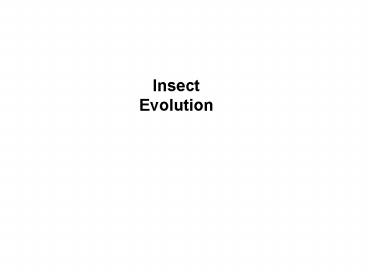Insect Evolution PowerPoint PPT Presentation
1 / 18
Title: Insect Evolution
1
Insect Evolution
2
500 400
300 200 100
0
Silurian
Devonian
Carboniferous
Permian
Triassic
Jurassic
Cretaceous
Entognatha
Archaeognatha
Zygentoma
Hexapoda
Ephemeroptera
Odonata
Insecta
Plecoptera
Embiodea
Pterygota
Zoraptera
Dermaptera
Grylloblattodea
?
Mantophasmatodea
Orthoptera
Phasmatodea
Blattaria
Isoptera
Mantodea
Neoptera
Psocoptera
Phthiraptera
Thysanoptera
Hemiptera
Coleoptera
Rhaphidioptera
Megaloptera
Neuroptera
Hymenoptera
Mecoptera
Holometabola
Siphonaptera
Diptera
Apterygotes
Strepsiptera
Trichoptera
Paleoptera
Lepidoptera
Hemimetabolous
Holometabolous
3
Relationships among Hexapoda
Collembola
Entognatha
Protura
Diplura
Hexapoda
Archaeognatha
Insecta
Thysanura
Pterygota
4
Evolution of the Insects
(Carpenter - 1953) Four stages in insect evolution
4. Development of metamorphosis
3. Development of wing flexion mechanisms
2. Development of wings
1. Appearance of primitive wingless insects
5
Stages of Insect Evolution (Carpenter, 1953)
1. Apterygotes
First insect fossils
First terrestrial arthropod fossils
First terrestrial arthropod trace fossils
6
Stages of Insect Evolution (Carpenter, 1953)
1. Apterygotes on Land
Devonohexapodus - marine hexapod from the
Devonian
7
Stages of Insect Evolution (Carpenter, 1953)
2. Development of wings
a. From what structural elements are wings
composed?
b. For what purpose were wing-like structures
first used?
2. Development of wings
8
Stages of Insect Evolution (Carpenter, 1953)
2. Development of wings
1. Paranotal Theory
paranotal lobes
Paleodictyoptera
9
Stages of Insect Evolution (Carpenter, 1953)
2. Development of wings
1. Paranotal Theory
venation
lobes
10
Stages of Insect Evolution (Carpenter, 1953)
2. Development of wings
2. Gill Theory
11
Stages of Insect Evolution (Carpenter, 1953)
2. Development of wings
2. Gill Theory
12
Stages of Insect Evolution (Carpenter, 1953)
3. Wing Flexion
13
500 400
300 200 100
0
Silurian
Devonian
Carboniferous
Permian
Triassic
Jurassic
Cretaceous
Entognatha
Archaeognatha
Zygentoma
Hexapoda
Ephemeroptera
Odonata
Insecta
Plecoptera
Embiodea
Pterygota
Zoraptera
Dermaptera
Grylloblattodea
?
Mantophasmatodea
Orthoptera
Phasmatodea
Blattaria
Isoptera
Mantodea
Neoptera
Psocoptera
Phthiraptera
Thysanoptera
Hemiptera
Coleoptera
Rhaphidioptera
Megaloptera
Neuroptera
Hymenoptera
Mecoptera
Holometabola
Siphonaptera
Diptera
Strepsiptera
Trichoptera
Lepidoptera
14
Stages of Insect Evolution (Carpenter, 1953)
3. Wing Flexion
Ephemeroptera
3. Development of wing flexion mechanisms
Odonata
Ephemeroptera Odonata Paleoptera
15
Stages of Insect Evolution (Carpenter, 1953)
3. Wing Flexion
16
Stages of Insect Evolution (Carpenter, 1953)
3. Wing Flexion
Development of wing flexion mechanism 1.
Neopterous condition 2. Allowed for better
running locomotion, etc. 3. Became dominant
and today represents 90 of orders and 97 of
species 4. Includes all other modern insects
17
Stages of Insect Evolution (Carpenter, 1953)
4. Development of Metamorphosis
Hemimetabolous (Incomplete metamorphosis)
Holometabolous (Complete metamorphosis)
18
500 400
300 200 100
0
Silurian
Devonian
Carboniferous
Permian
Triassic
Jurassic
Cretaceous
Entognatha
Archaeognatha
Zygentoma
Hexapoda
Ephemeroptera
Odonata
Insecta
Plecoptera
Embiodea
Pterygota
Zoraptera
Dermaptera
Grylloblattodea
?
Mantophasmatodea
Orthoptera
Phasmatodea
Blattaria
Isoptera
Mantodea
Neoptera
Psocoptera
Phthiraptera
Thysanoptera
Hemiptera
Coleoptera
Rhaphidioptera
Megaloptera
Neuroptera
Hymenoptera
Mecoptera
Holometabola
Siphonaptera
Diptera
Apterygotes
Strepsiptera
Trichoptera
Paleoptera
Lepidoptera
Hemimetabolous
Holometabolous

